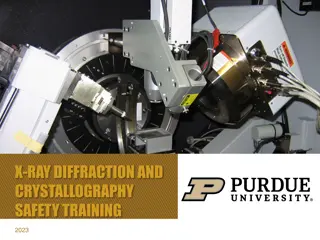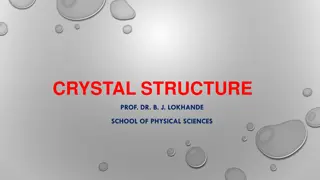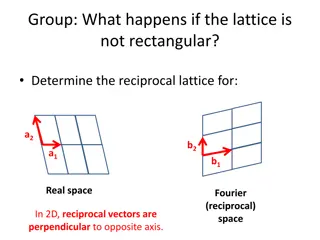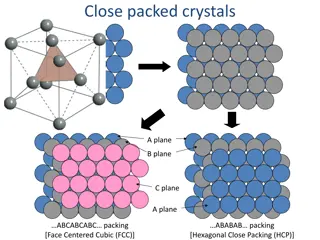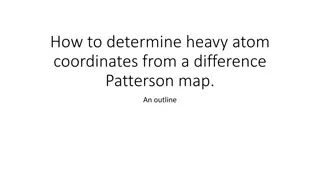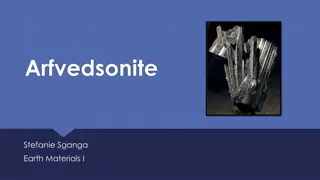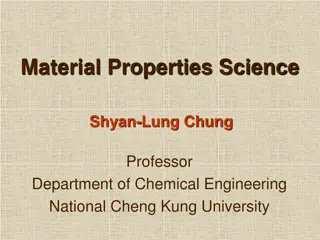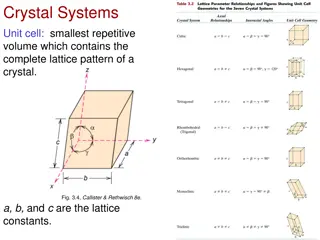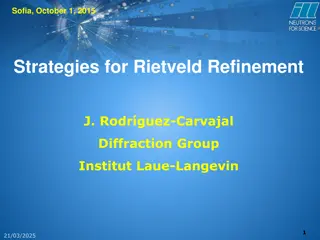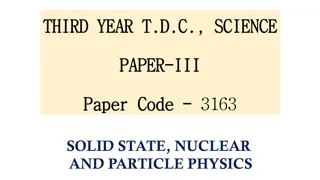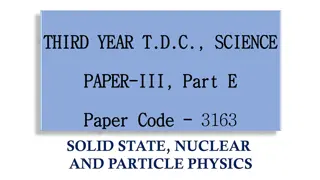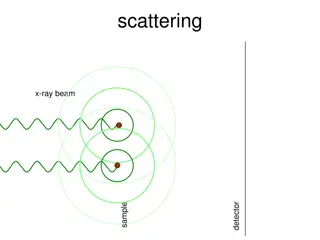X-ray Diffraction and Crystallography Safety Training Overview
X-ray diffraction and crystallography involve the use of ionizing electromagnetic radiation, specifically X-rays, which pose health risks if not handled properly. This training covers principles of X-ray safety, the importance of shielding materials like lead, steel, and concrete, X-ray production m
6 views • 44 slides
Crystal Structures and Types of Solids in Materials Science
Crystal structures in materials science involve the arrangement of atoms in solids, with examples of crystalline and amorphous solids like metals and glass. Explore concepts like energy packing, definitions of crystalline materials, unit cells, BCC and FCC lattices, HCP structures, and Miller Indice
13 views • 12 slides
Reciprocal Lattices in Crystal Structures
Explore the concept of reciprocal lattices in crystal structures, including non-rectangular lattices, Fourier space in 2D, Wigner-Seitz cells, Brillouin Zones, and the relationship between BCC and FCC structures. Learn about primitive lattice vectors, construction of the Brillouin Zone, and the sign
1 views • 49 slides
The C2h Point Group: Character Table, Characteristics, and Subgroups
Characteristics of the C2h point group, including its order and irreducible representations, as well as details on its symmetry elements and subgroups. Examples of molecules with C2h symmetry are provided. Explore the construction and properties of the C2h point group in crystallography.
1 views • 10 slides
Solid State Physics - Crystal Structures, Binding, and Nucleus Properties
Delve into crystallography, solid-state binding, semiconductor conduction, nucleus structure, and particle detectors in this comprehensive syllabus for Third Year T.D.C. Science students.
3 views • 16 slides
Radiation Damage in Crystallography
Explore the impact of radiation damage on crystallography, focusing on dose proportional to photons per area rather than time or heat. Learn about MGy, radiation damage world records, crystal lifetime based on flux and dose, and self-calibrated damage limits. Discover insights from various studies a
1 views • 71 slides
Crystal Lattice Planes and Indices
Exploring the significance of crystal lattice planes in determining parameters, diffraction methods, and orthogonal systems. Discover how to identify planes and calculate distances in various lattices using Miller indices. Visual aids provide clarity on hexagonal structures and symmetry in crystallo
1 views • 22 slides
Interactions of Planar Organic Radicals: Stacking and Bonding
Examination of the stacking interactions and bonding in planar organic radicals reveals a variety of non-covalent and weak covalent interactions such as hydrogen bonding, halogen bonding, and pancake bonding. This study highlights the significance of multicentric two-electron bonding and explores th
4 views • 29 slides
Resolution in Crystallography
Explore the intricacies of crystallography resolution, data cutting strategies, and publication criteria in chemical crystallography. Learn about R factors, Gaussian error averaging, and the importance of accurate data reporting. Discover the wisdom of our ancestors in crystallography research.
0 views • 56 slides
Crystal Geometry Systems and Symmetry Elements
Crystal geometry involves the study of seven crystal systems defined by three symmetry elements - centre of symmetry, planes of symmetry, and axes of symmetry. These symmetry elements play crucial roles in determining the geometric properties of crystals. The centre of symmetry, plane of symmetry, a
5 views • 12 slides
Deciphering Heavy Atom Coordinates from Difference Patterson Map: An Overview
Understanding how to determine heavy atom coordinates from a difference Patterson map involves recognizing the relationship between Patterson peak coordinates (u,v,w) and space group symmetry operators in crystallography. By solving equations that relate these coordinates, the absolute positions of
5 views • 5 slides
All About Arfvedsonite: Rare Mineral Formation and Properties
Arfvedsonite is a rare mineral that is only formed in iron-rich igneous intrusions associated with nepheline syenites and pegmatites. Discovered in 1823 and named after Swedish chemist Johan Arfwedson, it has a distinctive chemical formula and structure as an amphibole mineral. Its physical properti
1 views • 9 slides
Comprehensive Course on Material Properties and Science
Delve into the world of material properties and science with a course led by Professor Shyan-Lung Chung from the Department of Chemical Engineering at National Cheng Kung University. Explore topics ranging from atomic scale structures to mechanical properties and their applications, supported by opt
3 views • 10 slides
The SQUEEZE Tool in PLATON for Solvent Refinement
The SQUEEZE tool in PLATON, developed by Utrecht University, offers an effective method for handling disordered solvent refinement in crystallography. This tool, part of the SHELXL suite, aids in modeling and refining solvent parameters when traditional methods may not suffice. Learn about its histo
0 views • 23 slides
CIF and SHELXL-2014: Key Concepts Explained
CIF (Crystallographic Information Framework) and SHELXL-2014 play vital roles in data exchange and archival for crystallography. The CIF standard, along with FCF validation, ensures accuracy in structural data publication. Learn about embedding experimental data, refinement instructions, and the ABI
2 views • 22 slides
Laws of Crystallography: Understanding Crystal Structures
Discover the fundamental laws governing crystal structures including the Law of Constancy of Interfacial Angles, Law of Symmetry, and Law of Rational Indices. Explore how these laws define the angles, symmetry, and indices of crystals, offering insights into their formation and properties.
3 views • 24 slides
Engineering Metallurgy
This course at SVPCET, Nagpur delves into engineering materials, crystallography, phase transformation, atomic structures, equilibrium diagrams, heat treatment processes, and more. Students learn to recognize the properties of various metals, alloys, and their applications. The curriculum covers sol
1 views • 10 slides
Protein Structures Program and Data Processing
Today's program includes examination of protein structures using X-ray crystallography, statistical analysis, and processing of biological data. The provided information covers details such as PDB files, residue numbering, atom attributes, resolution measurements, B-factors, and occupancies. Learn a
2 views • 27 slides
Crystal Systems Unit Cell: Smallest Repetitive Volume with Lattice Pattern
Unit cell plays a crucial role in defining crystal structures and systems, showcasing the intricate atomic arrangements within. Explore crystallographic directions, indices determination, and more within the realm of crystallography.
3 views • 8 slides
Crystal Geometry and Lattice Structures in Science
Crystal geometry involves understanding primitive lattice cells, crystal structures, lattice parameters, and Miller indices. Explore the concepts of crystallography and crystal planes in this comprehensive science study material.
3 views • 12 slides
Crystal Geometry and Lattice Parameters Explanation
Crystal geometry involving primitive lattice cells, lattice parameters, and crystal planes with Miller indices explained in detail. Learn about the minimum volume cell used to build crystals and the orientation of lattice planes in crystals. Dive into the world of crystallography and understand the
2 views • 5 slides
Crystal Geometry and Lattice Cells
A primitive lattice cell, also known as a unit cell, is the minimum volume cell used to build a crystal. Explore crystal geometry, lattice parameters, and primitive cells in the context of crystallography. Learn about crystal lattice planes, Miller indices, and Wigner-Seitz primitive cells.
2 views • 32 slides
Recent Developments in Crystallography: Tests, Regeneration of Values, and Systematic Analysis
This update covers recent developments in crystallography, including tests, regeneration of values for bonds and bond-angles, validation, system analysis, and bug fixing. It also highlights the use of different input file formats and the advancements in the CCP4 repository. The focus is on refining
3 views • 20 slides
Miller Indices in Crystallography
Miller indices, devised by British mineralogist William Hallowes Miller in 1839, provide a method to describe the orientation of planes and directions within a crystal lattice. These indices, represented by a group of three numbers, help in determining the arrangement of atoms in a crystal structure
2 views • 7 slides
Protein Expression and Proteomics (PEP) Core Update and Expansion
The Protein Expression and Proteomics (PEP) Core is updating its facilities, adding new staff, and expanding services. The core goals include protein cloning, expression, purification, and analysis. New capabilities include FPLC systems, mass spectrometry, crystallography support, and viral activity
12 views • 9 slides
Advanced Strategies for Rietveld Refinement in Crystallography
Explore advanced techniques for Rietveld Refinement in crystallography, including model construction, data exploitation, and constraint application. Learn how to solve complex structural problems and optimize resolution for accurate results in your experiments.
0 views • 43 slides
Crystallography and Solid-State Physics Syllabus in Science Paper - III
Explore crystal geometry, types of binding in solids, semiconductor conduction, nucleus structure, and particle detectors in this comprehensive syllabus for Science Paper - III covering key topics in crystallography and solid-state physics.
2 views • 16 slides
X-ray Diffraction & Crystallography Lecture Overview
Explore the world of crystallography with Dr. Rob Jackson in the CHE-20031 lecture series. Learn about unit cells, crystal planes, Bragg's equation, and more. Get valuable resources and dive into the fascinating realm of structural inorganic chemistry through X-ray diffraction. Join upcoming lecture
3 views • 28 slides
Crystallography and Quantum Mechanics in Electron Behavior
Explore the connection between crystallography and quantum mechanics in understanding electron behavior within materials. Discover how the free electron model and Schrödinger equation play crucial roles in predicting electron movements and properties, ultimately shedding light on fundamental princi
3 views • 19 slides
X-ray Crystallography in Geology: Discoveries and Applications
Explore the fascinating world of X-ray crystallography in geology, from the discovery of X-rays to the intricate details of electron transitions. Learn about the Einstein Equation, conversion to kinetic energy, white radiation effects, X-ray tubes, electron shells, copper spectra, absorption edges,
0 views • 29 slides
Crystallography: Diffraction of X-rays by Crystal Lattice
Explore the fascinating world of crystallography through the study of X-ray diffraction by crystal lattices. Discover how X-rays interact with atomic structures to provide valuable insights into the arrangement of atoms in crystals. Delve into the principles of diffraction effects and the role of at
1 views • 11 slides
Crystallography
Delve into the world of crystallography, the science of determining atomic arrangements in crystalline solids. Discover the types of crystals, unit cells, space lattices, and more. Learn about the history, types, and significance of crystallography in this comprehensive guide.
4 views • 20 slides
X-ray Scattering and MAD Techniques in Crystallography
Explore the world of X-ray scattering, Bragg's Law, anomalous scattering, and Multiple Anomalous Diffraction (MAD) techniques in crystallography. Discover how photon energy and cross-section play a crucial role in understanding atomic structures using X-ray beams.
4 views • 48 slides
Crystallography and Crystal Symmetry
Explore the fascinating world of crystallography, where crystals are polyhedral solids with defined geometric shapes and symmetrical arrangements of atoms or molecules. Learn about the parts of a crystal, crystallographic axes, crystal symmetry involving planes and axes of symmetry, and crystal syst
3 views • 15 slides
Crystallography: Understanding X-ray Diffraction in Crystals
Explore the fascinating world of crystallography and X-ray diffraction in crystals. Learn how X-rays interact with crystal lattices, revealing the atomic arrangements and creating diffraction patterns essential for crystallography research. Delve into the principles behind crystal diffraction effect
2 views • 11 slides
Understanding Reciprocal Lattice in Crystallography
Delve into the concept of reciprocal lattice in crystallography, exploring how the orientation of planes is defined, the relationship between direct and reciprocal space, the significance of Bragg's law in diffraction patterns, the practical use of reciprocal space in experimental measurements, and
5 views • 12 slides
Understanding Crystallography: Symmetry in Nature, Arts, and Industry
Explore the world of crystalline states, symmetry in nature, arts, and industry, with a focus on basic symmetry concepts and crystallography in two and three dimensions. Discover the significance of symbols, conventions, transformations of indices, and various two-dimensional lattice systems in crys
3 views • 28 slides
Exploring Crystalline Symmetry in Nature, Arts, and Industry
Discover the beauty of symmetry in the crystalline state through nature, arts, and industry. Explore the basic concepts of symmetry and crystallography in two and three dimensions. Uncover the intricate patterns of symmetry in animated nature, works of art, and industrial designs. Delve into the phy
2 views • 20 slides
Exploring Symmetry and Crystallography in Nature, Arts, and Industry
Delve into the world of symmetry in nature, arts, and industry through crystallography, exploring concepts like symmetry elements, rotoinversion, glide planes, screw axes, and axial combinations. Discover the beauty of symmetry in two and three dimensions, along with the fascinating geometric princi
0 views • 34 slides
Advanced Crystallography Developments
Explore recent advancements including outlier analysis, regeneration of bond values, validation processes, and database improvements in Crystallography Open Database (COD) and CCP4 Monomer Library. Learn about the challenges and solutions in handling chemical data for crystallography applications.
1 views • 20 slides
